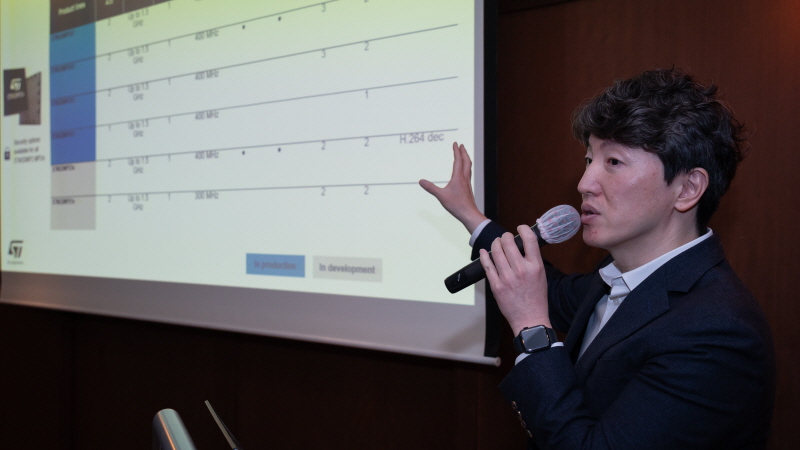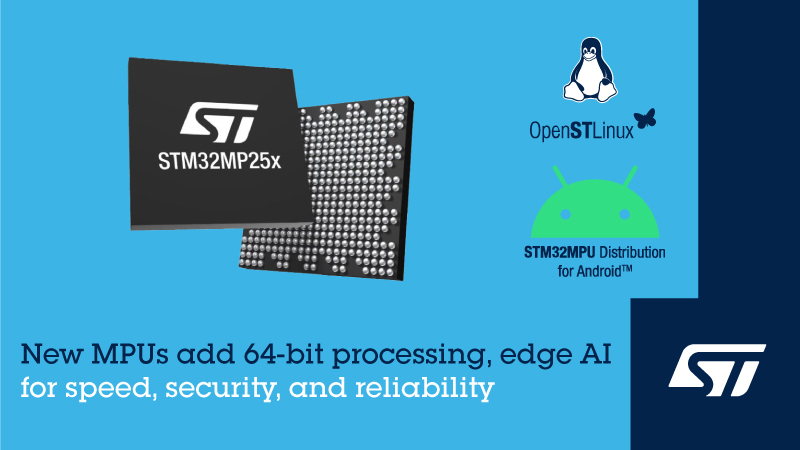ST마이크로일렉트로닉스(이하 ST)가 스마트 팩토리, 스마트 헬스케어, 스마트 빌딩, 스마트 인프라의 향후 발전을 견인하는 새로운 2세대 산업용 마이크로프로세서(MPU)인 STM32MP2 시리즈를 출시했다.
 ▲현대성 ST 코리아 GPM 부문 마케팅 부장(사진 제공: ST)
▲현대성 ST 코리아 GPM 부문 마케팅 부장(사진 제공: ST)
STM32MP2 MPU, 64bit 프로세싱·엣지 AI 가속 기능 탑재
STM32 에코시스템 활용 신속한 개발·보안 프로비저닝 지원
ST마이크로일렉트로닉스(이하 ST)가 스마트 팩토리, 스마트 헬스케어, 스마트 빌딩, 스마트 인프라의 향후 발전을 견인하는 새로운 2세대 산업용 마이크로프로세서(MPU)인 STM32MP2 시리즈를 출시했다.
ST는 19일 강남 노보텔 엠배서더에서 기자간담회를 열고 STM32 신제품과 솔루션을 소개하는 자리를 가졌다.
현대성 ST 코리아 GPM 부문 마케팅 부장은 2024년 6월 양산에 들어가는 STM32MP2를 소개하며 진화하는 디지털 세계의 기반을 구축하는 차세대 장비를 구동한다고 설명했다.

이러한 장비로는 산업용 컨트롤러 및 머신 비전 시스템, 스캐너, 의료용 웨어러블, 데이터 애그리게이터(Data Aggregator), 네트워크 게이트웨이, 스마트 가전, 산업용 및 가정용 로봇 등이 있다.
STM32MP2 MPU는 64bit CPU인 Arm Cortex®-A35를 포함하고 있는 ST 최초의 MPU로, 1세대 STM32MP1 디바이스보다 메인 프로세싱 성능이 향상됐다.
이러한 MPU의 높은 효율성은 실제로 액티브 냉각장치를 사용하지 않고도 시스템 설계가 가능해 더 작은 크기, 조용한 동작, 뛰어난 신뢰성, 전력소모 감소와 같은 이점을 제공한다.
3D GPU는 최대 1080p 디스플레이를 지원하며, 병렬 LVDS 및 DSI 인터페이스 기반의 풀 HD 비디오 파이프라인이 포함된 강력한 멀티미디어 기능도 갖추고 있다.
ISP와 MIPI CSI-2 카메라 인터페이스를 통해 최첨단 머신 비전 애플리케이션에 대한 지원도 강화됐다.
또한 2포트 스위치가 있는 최대 3개의 기가비트 이더넷 포트와 이더넷 TSN(Time-Sensitive Networking) 등 더욱 강력한 산업용 인터페이스가 지원된다.
PCIe Gen2, USB 3.0 및 3개의 CAN-FD 인터페이스를 통해 보다 쉽게 다양한 통신 및 제어 애플리케이션에도 통합이 가능하다.
STM32MP2 MPU는 최첨단 사이버 보안 기능과 함께, 까다롭고 시간에 민감한 작업부하와 AI 추론, 통신을 지원하도록 설계됐으며, 최대 10년 동안 연속 동작이 가능하도록 제작됐다.
새로운 STM32MP2 디바이스의 최첨단 보안 기능은 ST의 독보적 보안 하드웨어, 변조방지 제어, 펌웨어 보호, 보안 프로비저닝 등이 적용됐으며, Arm®의 트러스트존(TrustZone®) 아키텍처와 함께 동작하면서 중요한 데이터 및 키에 대한 기밀화를 유지한다.
STM32MP2 MPU는 IoT 기기 및 규정준수를 위한 업계 선도적인 보안 테스트 방법론인 SESIP 레벨 3 인증 및 전 세계 주요 지역에서 갈수록 엄격해지는 사이버 보호 요건을 충족할 수 있다.
여기에는 2025년 의무화되는 미국의 사이버트러스트(CyberTrust) 마크와 EU의 무선기기지침(RED: Radio Equipment Directive) 등이 있다.
스테판 헨리(Stephane Henry) ST 범용 MPU 사업부 사업 본부장은 “ST의 임베디드 MPU는 더 빠른 응답과 효율 향상을 위해 IoT 엣지에 구축되는 스마트 기기에 대해 더 많은 작업부하와 수요를 요구하는 흐름에 대응할 수 있다”며, "새롭게 출시된 STM32MP2 디바이스는 가장 강력한 프로세싱 엔진과 엣지 AI를 추가하면서 성능 범위를 확장한 것은 물론, STM32 에코시스템 지원으로 제품 개발을 가속화한다”고 밝혔다.
마르코 템포리티(Marco Temporiti) ISEO의 R&D 소프트웨어 매니저는 “ISEO는 ST와 함께 장치를 클라우드와 연결하는 문제를 해결했으며 원격 잠금 해제부터 새로운 접근권한 부여에 이르기까지, 당사의 제품은 액세스 관리의 미래를 만들어가고 있다”며, “강력한 암호화 기능을 갖춘 STM32MP2 마이크로프로세서를 활용했기 때문에, 전례 없는 신뢰성과 보안을 갖춘 산업용 등급 게이트웨이를 구현할 수 있다”고 전했다.
그는 이어 “욕토 리눅스(Yocto Linux)와의 원활한 통합으로 개발 프로세스를 간소화하고 보다 쉽게 혁신을 실현할 수 있으며 특히 ST의 10년 제품공급 보증 프로그램은 경제적인 비용으로 긴 제품 수명주기를 보장함으로써 업계의 새로운 기준을 수립했다”고 말했다.

